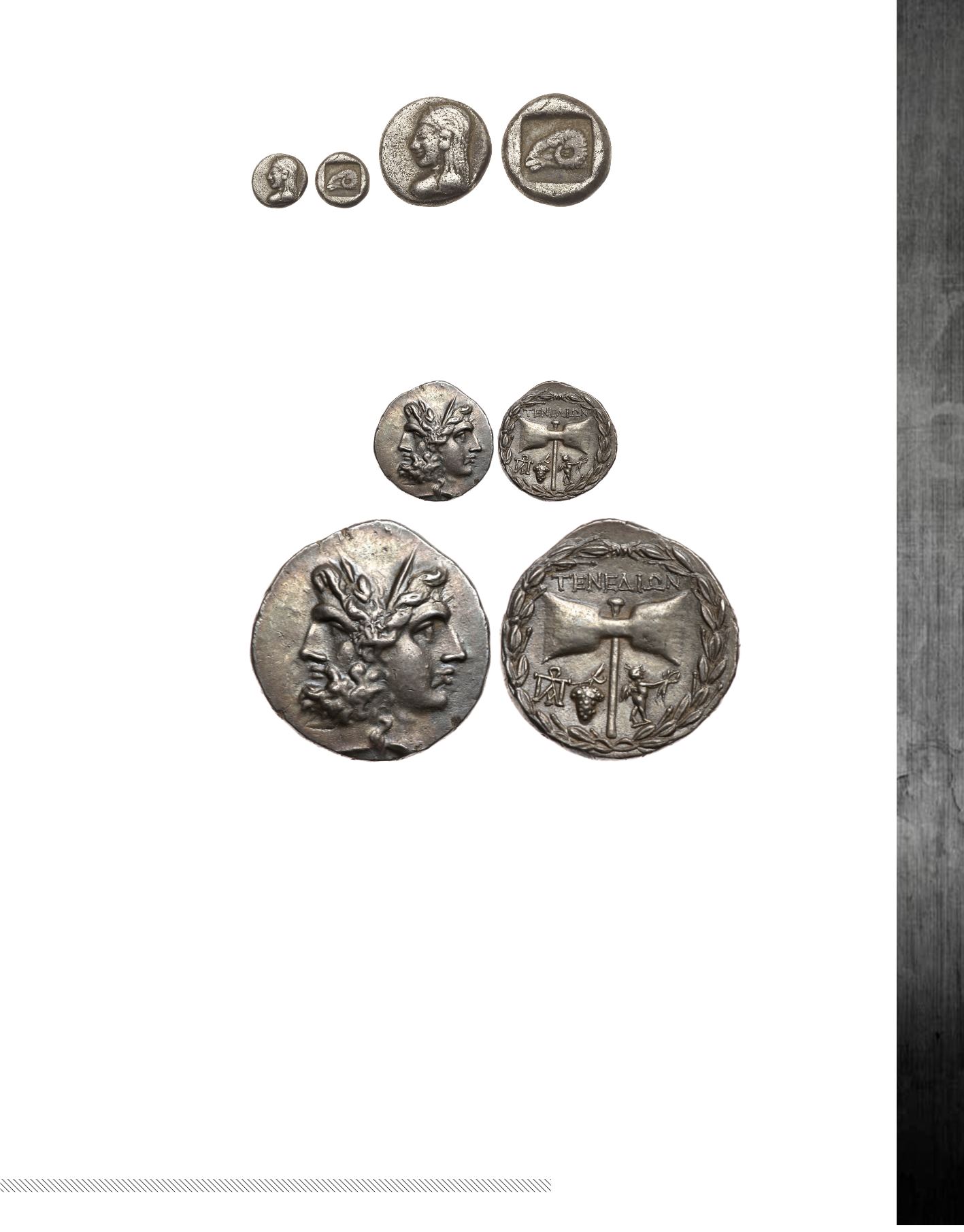

82
bid online at
www.goldbergcoins.com(800) 978-COIN (2646)
|
Ancient Coins
Enlargement
1700 Troas, Kebren. Silver Drachm (3.64 g), 5th century BC
. Archaic female bust left.
Reverse:
Head of ram left within incuse square. SNG Ash-
molean -; SNG von Aulock 1545.
Very Rare.
Fine archaic style. Toned.
Very Fine
.
Estimate Value ............................................................................................................................................................................ $400 - 500
The Hanbery Collection; Purchased privately from F. Kovacs in the 1980s.
W
ONDERFUL
S
ILVER
T
ETRADRACHM OF
T
ENEDOS
,
CA
. 100-70 BC
1701 Islands off Troas, Tenedos. Silver Tetradrachm (16.49 g), ca. 100-70 BC
. Janiform male and female heads, the male laureate, the female
diademed.
Reverse:
TENE
I
N, double-axe; in left field, monogram and grape bunch; in right field, Eros right, holding wreath; all within laurel
wreath. Callataÿ 74-77 (D14/R-); SNG Berry 988 (same obverse die). Well struck and nicely centered. Attractive uniform old cabinet tone.
Extremely Fine
.
Estimate Value .......................................................................................................................................................................$2,500 - 3,000
From the Hanbery Collection; Purchased from an old Sotheby' s sale with ticket.
This tetradrachm of Tenedos with its laurel wreath reverse border belongs to the so-called "wreath-bearing" class of tetradrachms struck in Greece
and throughout western Asia Minor and the Near East in the second half of the second century BC and continuing into the early first century BC.
While many of the Asia Minor issues have been linked to Attalid meddling in Seleukid Syria in the second century BC, the Tenedian series is later
and probably reflects support for the Pontic king Mithradates VI Eupator in his wars against the Romans. At the outbreak of the Third Mithradatic
War (73-63 BC), Tenedos served as a naval base for Mithradates' pirate fleet and was the scene of a decisive Roman victory that compelled the
Pontic king to flee to the relative safety of the Bosporos. The double-axe reverse type refers to the myth of Tenes, the eponymous hero of the
island of Tenedos. According to the story, Tenes was the son of Apollo or King Kyknos of Kolonai and Proklia, a daughter or granddaughter of Lao-
medon. When Tenes was falsely accused of rape against a certain Philonome - charges bolstered by the false testimony of a flautist named Eumol-
pos - Kyknos entombed the hero and his sister Hemithea in a chest and set them adrift in the sea. The chest eventually ran ashore on the island
of Leukophrye, where the inhabitants proclaimed Tenes their king and renamed their home Tenedos in his honor. Kyknos later learned the truth
and tried to set things right. He executed Eumolpos and buried Philonome alive and then sailed to Tenedos to reconcile with Tenes and Proklia.
However, when his ship landed on the island, Tenes took up an axe and cut the moorings to show that he had no interest in reconciling with a
father who took the word of a flute player over that of his son. Tenes later went on to support the Trojan side against the Greeks in the great Tro-
jan War and was killed by Achilles. When the Tenedians later erected a temple to Tenes it was forbidden for any flautist to enter or for the name
of Achilles to ever be spoken. As is frequently the case with janiform heads, the proper identity of those on the obverse has been a source of dis-
agreement among numismatists. Some see the male and female heads as representing Zeus and Hera while others have thought that they depict
Tenes and Proklia. Only the ancient Tenedians knew for sure, and they aren' t telling.
Enlargement



















